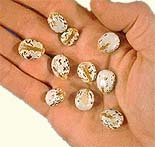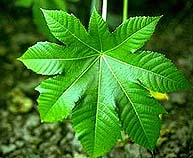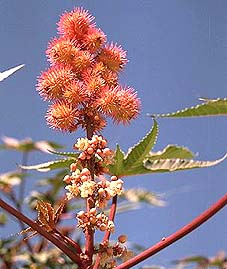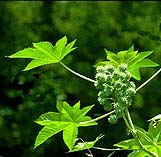Castor oil plant
Ricinus communis Castor bean fruit has been found in ancient Egyptian sarcophagi among the objects that should accompany the dead in their voyage through the Land of Death. |
The castor oil plant has large palm-shaped leaves with 7-9 portions, cluster-like blossoms and prickly fruits, each carrying 3 seeds. All parts are poisonous, especially the beans.
Castor beans affect all animals and humans. Even one of them may be sufficient to cause death. They contain some of the strongest toxins of our planetâs flora: the alkaloid ricinin and the toxalbumin ricin, the latter being a plant lectin, or protein, more toxic even than strychnos and cyanides. What is more, it has the ability to accumulate in the organism until the lethal dose is reached. The symptoms then are nausea and vomiting, stomachache, bloody diarrhea, headache, cold sweat, sleepiness, disorientation, fever, shortage of breath, seizures, followed by a collapse and death.
This ten-meter-high tree comes from Ethiopia in Africa and is now spread in the tropic and subtopic zones of Africa and Asia. |
|
| It is also cultivated in many other countries as an ornamental annual plant 1-2 m high. In the U.S.A., it also grows in waste areas and roadsides. 50-70% of its seed content is thick fatty oil, which contains vitamins A and Dâthe so-called castor oil. It has been used as a purgative in medicine since ancient times. After heat treatment, castor oil is a good food source for cattle. |




